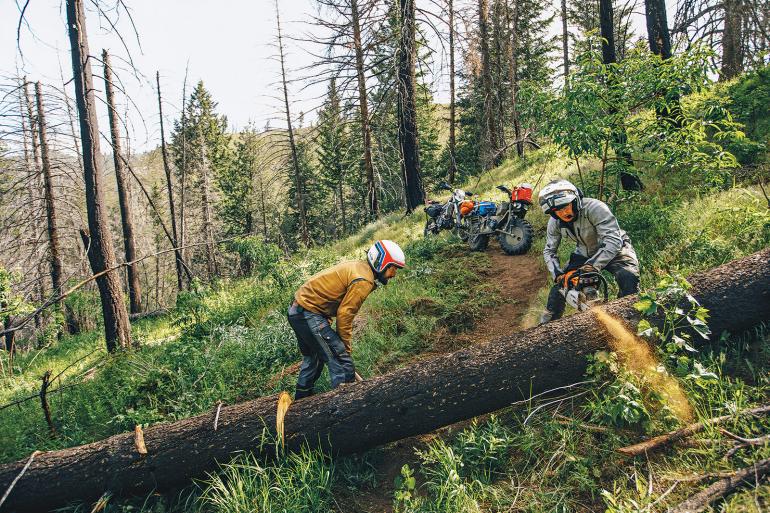Shifting Gears
Reimagining shared-use trail ethics.
You know those days where everything seems to line up perfectly without much thought? This was starting out to be one of those days. A few friends and I had agreed on a day of mountain biking along the Bangtail Divide. We rose early to avoid the late-summer heat. The birds were chirping and the wildflowers were still out, high up in the mountains.
When we reached the midpoint of our ride, we stopped for a lunch break. As we took in the silence, the views, and the camaraderie, it suddenly became apparent that we were no longer alone. Behind us, we heard a distant hum that we quickly identified as a fleet of motors “brapping” our way, like a scene out of Mad Max. We packed up and fled down the trail, in hopes of delaying the inevitable.
It’s important to understand the full complement of benefits that motorized users provide.
It wasn’t more than five minutes until they overtook us. They came in twos and threes and fives. They came with few-fingered waves and were gone in a sputter. Our spirits sunk a little more with each passing motorcycle, and it seemed we couldn’t reach the car soon enough. What had started as a peaceful, solitary ride amongst friends, had devolved into a motocross rally that we were destined to lose. When we did finally reach the car, we were greeted by a smile and a wave by many of the same riders we saw out on the trail. We dismissed them with a disingenuous mimicking of gestures.
At home, I resolved to never find myself in this situation again, having to share the trail with moto riders. Heck, I would rather take a few horses. They don’t cause too much trouble compared to what I had endured earlier that day. So I sat down and pulled out my laptop to read up on where I could go that motorbikes couldn’t. That will solve the problem, I thought, just a little bit of partitioning.
Down the research rabbit-hole I went, and when I came out, I had an entirely new perspective. What I discovered was as beautiful a piece of irony as one could imagine. Turns out, the very trail I was on that morning happened to be maintained mostly by motorized users. So too with many other trails I regularly ride. And despite these maintenance efforts, there has been a slow movement over the years to push motors further off some of the trails they maintain, gobbling them up for non-motorized use.
That may sound fine and dandy for some, maybe even preferable, but it’s important to understand the full complement of benefits that motorized users provide. Firstly, motor-folk help fund the trails they ride—a portion of their vehicle-registration fees and gas taxes go to Montana Fish, Wildlife & Parks (FWP), funding trail maintenance. Additionally, their passes to access trails on public land are purchased directly from FWP, and go straight towards maintenance projects, signage, and other benefits for all trail users. Something that, as a non-motorized recreationist, I am guilty of taking for granted when I just hop on the trail and pay nothing.
With a different outlook, I now view my rides a little more open-mindedly. What is my problem with motorcycles anyway? Are they really that bad?
Finally, after a seamless run or ride on a multi-use trail, it’s easy to overlook all the work it took to build the trail. It’s no coincidence that the most well-cleared and buffed-out trails are often those same multi-use trails that allow motors. Motorcycle riders are able to carry heavy tools way back into the forest, whereas we’d otherwise be constrained to lighter equipment that can fit in packs or on panniers. I’ve found myself laboring away with a folding hand-saw for half an hour just to get through a few inches of fallen timber, a task that would be light work for a chainsaw strapped to a motorbike. Now, go look at some trails where motorized use is prohibited. You’re likely to find more frequent, uncleared deadfall and overgrown shrubbery, which at best can be difficult to navigate and at worst renders the trail impassable.
With a different outlook, I now view my rides a little more open-mindedly. What is my problem with motorcycles anyway? Are they really that bad? Am I really even worse off at all, sharing the trails with other types of people, other modes of travel? As it turns out, I’ve been benefiting from their contributions with no appreciation. Maybe we are all better off when we work together to create new opportunities and preserve the old ones. After all, behind the helmets of those motorcyclists are some of the nicest, most etiquette-aware folks around. Try to find as many hikers or mountain bikers that actually give you a polite wave on the trail as often as dirt-bikers do. Don’t worry, I’ll wait.












